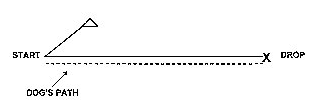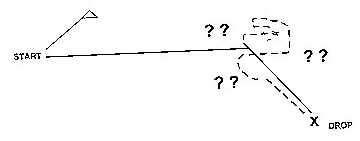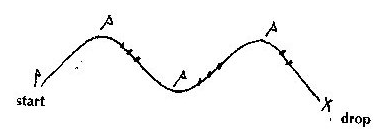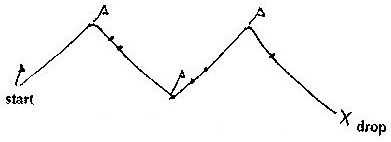Serpentine Tracks
A New Method Of Introducting Dogs To Tracking
Serpentine Tracks
All the existing literature on tracking introduces tracking by beginning with straight line tracks with a reward and/or article at the end. Some methods use food on the track, some don’t; some double or triple lay the tracks, and so on, but getting the dog used to straight lines before introducing terms is fundamental to all these methods.
Once the dog masters tracking in a straight line, turns are introduced. This has often been one of the first big problem areas for the dogs and handlers in tracking. The dogs get to the end of the straight leg, keep on going, lose the scent, get confused, wander around, and hopefully eventually figure out that the track goes in another direction. The handler also has to figure out what to do–do you stop, restrain the dog, let them wander (and how far do you let them get off the track?), or show them the new leg? All the while you are getting the lead tangled, being confused yourself, and further confusing the dog. Often the dog will get distracted and decide to do something else, and then you have to correct them for that. A typical pattern for the dog’s movement when introducing turns is shown below:

Straight Legs…

Then Turns
For this class, we will be trying a new approach to introducing dogs (and handlers) to tracking, one which we hope will sidestep the stress and confusion caused by learning straight legs and then being confused by turns. I learned about the method from the internet Tracking-L forum, from Dori Painter, who teaches her dogs for Schutzhund (abbreviation, SchH) tracking, and I received permission to use it in this class. In SchH, it is essential that the dog “footstep” track, that is, keep very close to the track and not air scent or fringe track. Therefore, SchH trackers use food on the track from the beginning to keep the dog’s nose close to the ground. This use of food, along with the use of a track laid in an arc instead of a straight line, encourages the dog to use its nose and not its eyes to find the track (and the food). Often when tracking is introduced using straight lines, food, and double or triple laid tracks, the scent is so strong that the dog learns right away that it can air scent, fringe track, or move in a straight line to find what it wants, rather than stay close to the actual track. When the dog learns these bad habits from the beginning, it becomes harder to “read” them when you begin blind tracks.
The First Tracks
We will start with a simple, single arc, with a diameter of approximately 20’. Food will be put on the track at first very frequently, so the dog is on a fun treasure hunt where following the track is its won reward. (The glove at the end is introduced to the dog in the same manner as in other methods.) The track should be laid with the wind at your back if possible, so as not to provide the dog with an overwhelming amount of scent. The track should be walked only once, not double or triple laid (this is important, since it would be very difficult to re-walk a track which is not in a straight line). You should put at least five flags along the arc so that you know exactly where you walked. The track will look something like this:

The track should be fairly “hot” (i.e. run very soon after you lay it) at first, about 10-15 minutes old. Keep the dog on a six foot lead. Don’t point to the track if you can help it. Encourage the dog quietly, with “good track” or “good dog” as they progress. Don’t worry if they miss some of the food — just ignore it. When they get to the end, have food on the glove, and play with it so that the dog learns that the glove is a wonderful reward.
When the dog successfully completes this first track, you should continue to lay tracks for him/her quite often (three or four times a week) during the first few weeks until he/she gets the idea about what tracking is. The tracks should be short, and not aged very long. Let the dog tell you how quickly to progress: if the dog starts skipping over some of the drops, it is okay to space the food out a little further. If the dog is running to the end of the track to play with the glove, make the track a little longer, or age it a little longer (but don’t add age and length at the same time). Once the dog can successfully complete a single arc of about 75-100 yards with very little food on the track, you might try removing the food from the track (leave it on or in the glove at the end), or try rubbing some food on the soles of your boots, instead (this also works with the chow hounds who spend five minutes at each drop to be sure they got every bit of food).
If all this has been completed successfully (this might take anywhere from a week to a month, depending on the dog and how often you track), then you can begin to introduce multiple arcs (serpentines). The dog may have some confusion initially when you introduce a change in direction. To help with this, you may want to put more food on the track at that point. The track will look like this:

Introducing A Second Arc
(Serpentine)
Use the same methods, and continue to track at least two or three times a week if possible. Increase age and length as the dog gains confidence. Do not hesitate to use a shorter, hotter track, or to use more food on the track if the dog is having problems. As they progress, begin to make the curves tighter and the spaces between them straighter. The tracks will begin to look like this:

Tightening The Arcs …

… Until They Become Turns
You may want to place food after the turns in order to give the dog an immediate reward when he/she makes the right decision. Continue on with tracking using the “traditional” methods from this point on, occasionally utilizing some meandering legs or arcs interspersed with “normal” turns to be sure the dog isn’t getting patterned into always doing straight legs and angled turns.
This method works incredibly well. You will find that you have a confident, happy tracking dog (and, thus, a more confident and happy handler) because the dog will make correct decisions from the beginning, rather than learning with straight-line tracks, introducing turns and making the dog be “wrong’, and then relearning that tracks are not always straight. They also learn from the beginning that they must use their noses and pay attention because the track could go anywhere, thus discouraging air-scenting and fringe tracking.
Good Luck!